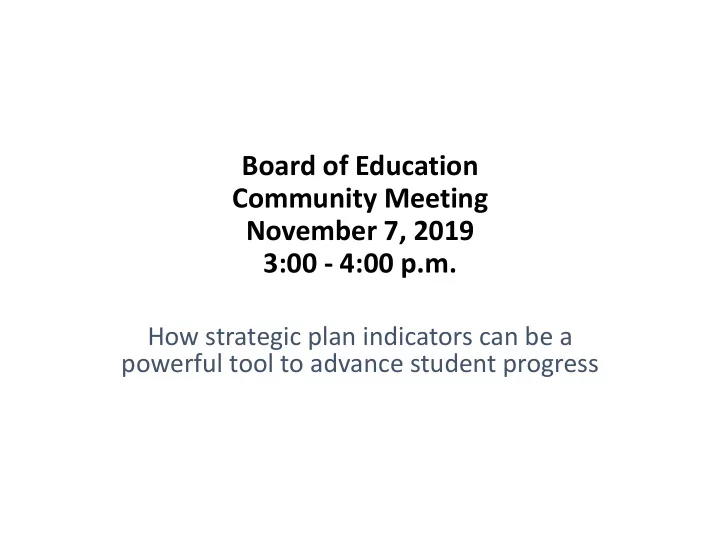

Board of Education Community Meeting November 7, 2019 3:00 ‐ 4:00 p.m. How strategic plan indicators can be a powerful tool to advance student progress
Meeting Objectives 1. Distinguish between leading and outcome indicators 2. Find connections between leading and outcome indicators 3. Understand how these connections can help drive system progress
How does a strategic plan drive student progress? College Career Strategic Plan Execution Students Citizenship
2017‐2020
Leading Indicators Teacher 3 rd Gr 9 th Grade Inclusion School Chronic Family Teacher R&M Position Literacy on track Rate Climate Absenteeism Engagement Retention Backlog Filled 3 rd Grade Literacy is a predictor of high‐school graduation Absenteeism affects student achievement Outcome Indicators ELA Graduation Math Science CTE College Going Achievement Rate Achievement Concentrator Rate Gap College Career and Citizenship Readiness Goal
DOE STATEWIDE STUDENT SUCCESS INDICATORS Year Difference on Year between change 2019‐ last stated 2016 (2019/2 2020 result and STATEWIDE STUDENT SUCCESS INDICATORS (Base) 2017 2018 2019 018)* (Target) target* 1 Chronic Absenteeism 15% 15% 15% 15% 0% 9% ‐6% 2 School Climate (% Positive) 72% 73% 74% 1% N/A N/A 3 Inclusion Rate 37% 37% 41% 44% 3% 51% ‐7% 4 3rd Grade Literacy 70% 65% 73% 76% ‐3% 5 9th Grade On‐Track 91% 91% 90% 94% ‐4% 6 Academic Achievement (ELA) 51% 51% 55% 54% ‐1% 61% ‐7% Academic Achievement (Math) 42% 43% 43% 43% 0% 54% ‐11% Academic Achievement (Science) 43% 46% 46% 44% ‐2% 64% ‐20% 7 Achievement Gap (ELA) 33 33 32 34 ‐2 25 ‐9 Achievement Gap (Math) 29 28 28 29 ‐1 22 ‐7 8 High School Graduation 82% 82% 83% 84% 1% 86% ‐2% 9 CTE Concentrator 38% 42% 48% 56% 8% 50% 6% 10 College‐Going Graduates 56% 55% 55% 55% 0% 62% ‐7% 11 Teacher Positions Filled N/A 93% 92% 92% 0% 96% ‐4% 12 Teacher Retention N/A 52% 54% 51% ‐3% 60% ‐9% 13 R&M Backlog (millions) N/A N/A N/A N/A N/A N/A N/A 14 Family Engagement N/A N/A 72% N/A N/A N/A N/A Source: DOE, DOE Dynamic Report, Achievement Gap (points), N/A (data not available), *green=positive change , red=negative change, black=no change
Source: DOE Dynamic Report
What does this suggest? College Career Strategic Plan Citizenship Execution Students (via indicators) (via indicators) • Perhaps the connections between leading indicators and outcomes measures are not strong enough to drive progress. • Perhaps the focus is not on the appropriate leading indicators to get to the desired outcomes.
EXERCISE: CONNECTING LEADING AND OUTCOME INDICATORS Complex 1 Complex 2 Complex 3 Large population of students Large population of English Large population of receiving special education learners economically disadvantaged services •Elementary school •Elementary school •Elementary school •Leading indicator 1 •Leading indicator 1 •Leading indicator 1 •Leading indicator 2 •Leading indicator 2 •Leading indicator 2 •Middle school •Middle school •Middle school •Leading indicators 1 •Leading indicators 1 •Leading indicators 1 •Leading indicators 2 •Leading indicators 2 •Leading indicators 2 •High school •High school •High school •Leading indicator 1 •Leading indicator 1 •Leading indicator 1 •Leading indicator 2 •Leading indicator 2 •Leading indicator 2 OUTCOME INDICATOR: HIGH SCHOOL GRADUATION
EXAMPLE: ELEMENTARY SCHOOL Teacher 3 rd Gr 9 th Grade Inclusion School Chronic Family Teacher R&M Position Literacy on track Rate Climate Absenteeism Engagement Retention Backlog Filled Teacher Absenteeism Graduation Rate Leading Indicator 1: 3 rd grade literacy Why? Students that can read at grade level in 3 rd grade is more likely to graduate from high school. Leading Indicator 2: School climate Why? Students will feel safe and more engaged in a positive school climate. Leading Indicator 3: Teacher absenteeism (created a new indicator) Why? Having the same teacher in the classroom consistently (instead of substitutes) is essential so that learning is consistent and students feel valued.
Post‐Exercise Reflection Did we meet our meeting objectives? 1. Distinguish between leading and outcome indicators 2. Find connections between leading and outcome indicators 3. Understand how these connections can help drive system progress
2030 Promise Plan Proposed Leading Indicators 2017‐20 Strat Plan Leading Indicators Environment Achievement Engagement Access Partnerships Enrollment 9 th Grade Honors 10‐year Chronic School Teacher for ʻāina‐based in Pre‐K diploma Facilities Absenteeism on track Climate Retention stewardship Plan Career Staff Equitable access pathway Teacher engagement 3 rd Grade 80% clean Inclusion Family to education access Position Literacy energy use Rate Engagement Filled by 2030 Grow Middle school access to student afterschool programming Access to postsecondary internships credits via (1) enrollment School Safety R&M for diploma in credit‐bearing Student health risk and Culture Plan Backlog credit coursework and (2) taking rates of credit‐bearing assessments Grow Access to HĀ externships Internships and teacher assessment of to scale 2017‐20 Strat Plan Outcome Indicators externships with industry learning real‐world environment relevance 2030 Promise Plan Proposed New Outcome Indicators in Achievement curriculum Gap Increase Seal English Language 2030 Promise Plan Proposed Future Indicators of Biliteracy Arts, CTE Math, and Concentrator Acquisition of post‐secondary Science credits via (1) students earning Achievement six or more credits and (2) Service students earning qualifying College Culturally Portfolio Ease of staff marks on credit‐bearing and Graduation learning Going relevant assessments “doing college entrance assessments Rate Rate assessments business”
Recommend
More recommend